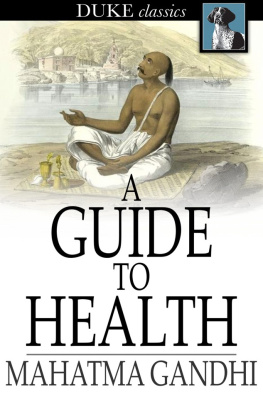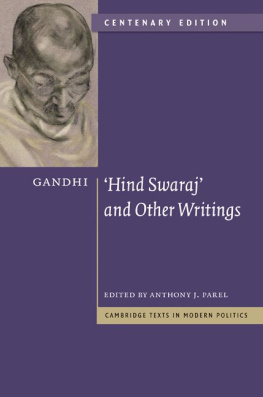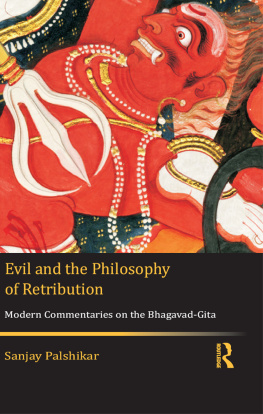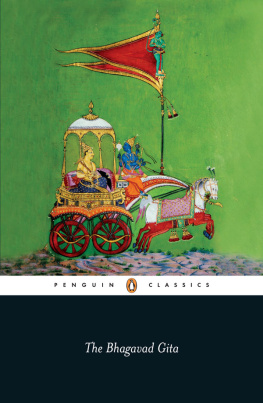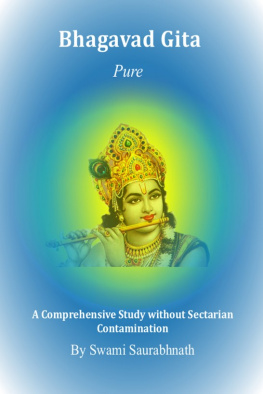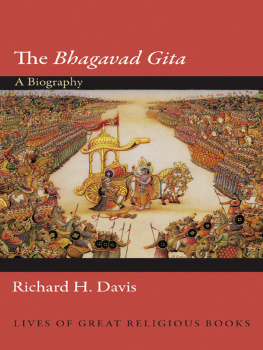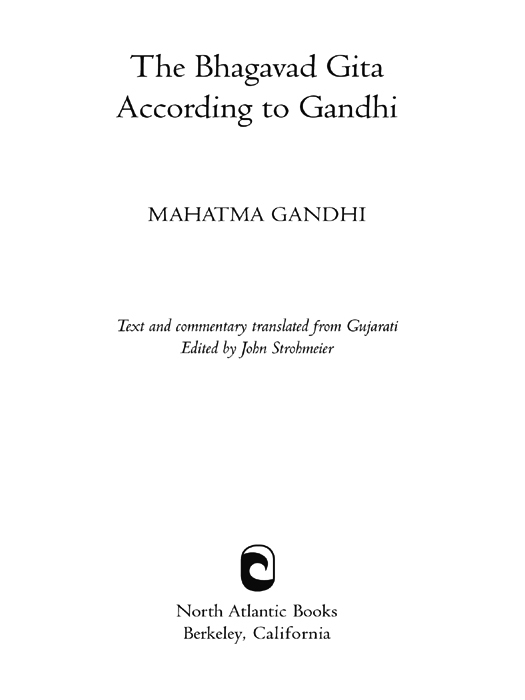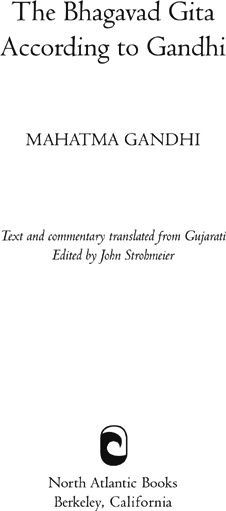Contents
Foreword
MICHAEL NAGLER
To write some words of introduction to this book is an honor I scarcely deserve. Millions believe, myself among them, that Mahatma Gandhi was the greatest human being to have walked through the turbulent pages of the twentieth century. And as for the Gita, its wisdom is unrivaled. As Julien Green says of the Christian Gospels in his biography of St. Francis, The book has a peculiar feature: You can listen to it year after year, and then a moment comes when from out of its pages comes a soundless, but deafening voice that you will never be able to silence. I have had such moments reading the Gita, as have millions of others.
It is important to grasp the relationship between this man and this book, this love-match between person and scripture. For Gandhi, the Gitas was a voice that changes forever the way one understands things, the source of a profound shift in behavior and vision. He describes, for example, how he was once almost undone by worldly concerns when a verse of the Gitachapter two, verse 15came to him, and the very next moment I was almost dancing with relief.
Such experiences do not come for the mere reading. Great as is the truth of the Gita, or any scripture, the readiness is all. The soil of our mind has to be cultivated for the seed of the truth to take such hold. That comment of Gandhi comes shortly before a sectionthe last eighteen verses of the second chapteron which he practiced meditation nearly every day of his adult life. In his morning and evening prayer meetings, Gandhi would use these verses to bring his mind to a standstilla state of utmost receptivity to Truth. We might ascribe such a reaction to faith, and thats not wrong. But faith doesnt come unbidden, it requires systematic cultivation.
In the modern era, theres a tendency to think that this cultivation is intellectual. That would be true if the purpose were merely to understand the scripture. But for Gandhi, understanding was only an adjunct to self-realization, almost an unnecessary one. The point is not just to understand, but to absorb, so that one unconsciously acts out the truth absorbed. At the back of my reading [of the Gita] there is the claim of an endeavor to enforce the meaning in my own conduct for an unbroken period of forty years. And he adds, quoting a proverb from Indian tradition, one may cast into the river a ton of thoughts and cling to an ounce of practice.
The good news is that no one lacks the endowment to find a practice. Intellectually we may not all be Einsteins, just as spiritually we may not all be born, as my teacher, Sri Eknath Easwaran, used to say, with a spiritual spoon in our mouth. But what the Gita teaches (and Gandhi unwaveringly did) is that by finding the right work and plugging away at it with determination, anyone can improve their capacity to absorb Truth. From this teaching I draw no small comfort.
If one wanted to pick the single hallmark of Gandhis behavior by which the sign of the Gitas influence could be read, it would almost certainly be desireless action. This requires a word of explanation. What one doesnt desire in this state is not an opportunity to act, nor that his or her action should do good. Its phalam, usually translated the fruit of ones action. This is literally correct, but more precisely it means that result which benefits us personally.
Gandhi gives two superb illustrations of this elusive discrimination and why it is crucial that we make it. Is it wrong to be attached to a positive goalsay, to the one he was fighting for with every ounce of his lifes strength? Yes, he answers, [for] if we are attached to our goal of winning liberty, we shall not hesitate to adopt bad means. Gandhi also collected millions of rupees from millions of individuals for the purpose of winning this goal, but, he maintained, if a person is particular that he would give coins to me personally, either out of attachment to Gandhi himself or out of a desire for recognition, one day he might even steal them. This subtle principle perhaps explains all of Gandhi, if one knew how to apply it.
I might give just one further illustration before stepping aside for the reader to draw his or her own conclusions, and benefits, from this remarkable book. One can be attached (in the negative sense) even to the highest truth Gandhi espousednonviolence. Nonviolence can become a mood rather than a power, a congratulatory way one thinks about oneself. When that happens, the belief in nonviolence is only thata belief, not an opening of ourselves to the inner forces of Truth. Hence, Gandhi explained, we see the seemingly contradictory posture of the Gitas Krishna, who urges the hero Arjuna, who represents you and me in his spiritual crisis and befuddlement, to fight while holding aloft the banner of nondiscrimination and nonviolence. Even if we believe in nonviolence, it would not be proper for us to refuse, through cowardice, to protect the weak. How do we know whether were refusing out of cowardice or nonviolence? That only a lifetime of practice can help us decide.
Editors Note
JOHN STROHMEIER
Gandhis Text and Commentary
The Bhagavad Gita According to Gandhi is based upon talks given by Mahatma Gandhi at Satyagraha Ashram in Ahmedabad, India between February 24 and November 27, 1926. During this timea period of withdrawal from mass political activityGandhi devoted much of his energy to translating the Gita from Sanskrit into his native Gujarati. This effort inspired him to address his followers almost daily, after morning prayer sessions, about its content and meaning as it unfolded before him.
Gandhis commentary was transcribed on the spot by his amanuensis, Mahadev Desai, and at least one other resident of the ashram, Punjabhai, but not until 1955 was it published in its entirety, in Gujarati. It first appeared in English in The Collected Works of Mahatma Gandhi, published by the Government of India in 1969. It is widely regarded as among the most important commentaries on the Gita produced in India in the twentieth century, alongside those of B. G. Tilak, Sri Aurobindo, and Sarvepalli Radhakrishnan.
For this edition, in an effort to bring forward and clarify the essence of Gandhis thinking, I have abridged the commentary considerably, and rearranged it in a few sections. The original presentation of the material was unrehearsed and relatively spontaneous, and includes many of the redundancies, contradictions, ellipses, false starts, and situational digressions of everyday conversation. Some of these I have deleted after pursuing the trail of Gandhis thought carefully and respectfully. (Among these deletions is one from chapter eight, lines 910, where Gandhi observes that one who keeps his mouth shut attains to the realm of the Supreme; certainly a comment to the restless boys in his audience.)
Others I have let stand where they illuminated important ideas, or explained the context in which he made his remarks. For example, his references to an impending flood, the killing of a snake, and the tormenting of a dog by some boys, although quite specific to ashram events, carry lessons that apply to the world beyond the ashram walls.
About the Gita
The Bhagavad Gita, The Song of the Lord, is a 700-line section of a much longer Sanskrit war epic, the Mahabharata. The Mahabharata tells the story of a legendary conflict between two branches of an Indian ruling family that may have taken place between 1000 and 700 B.C. Authorship of the poem is traditionally ascribed to Vyasa, who perhaps lived between the fifth and third centuries B.C.


